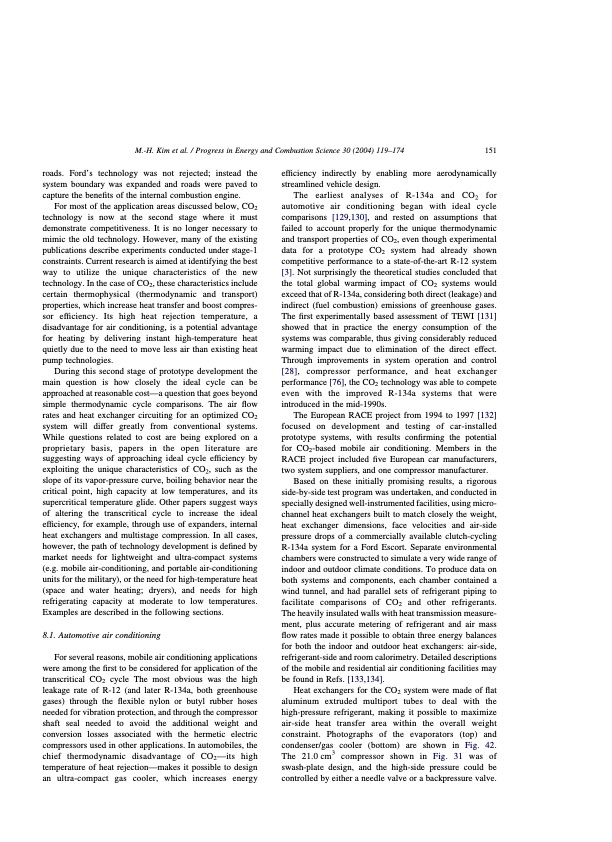
PDF Publication Title:
Text from PDF Page: 033
M.-H. Kim et al. / Progress in Energy and Combustion Science 30 (2004) 119–174 151 roads. Ford’s technology was not rejected; instead the system boundary was expanded and roads were paved to capture the benefits of the internal combustion engine. For most of the application areas discussed below, CO2 technology is now at the second stage where it must demonstrate competitiveness. It is no longer necessary to mimic the old technology. However, many of the existing publications describe experiments conducted under stage-1 constraints. Current research is aimed at identifying the best way to utilize the unique characteristics of the new technology. In the case of CO2, these characteristics include certain thermophysical (thermodynamic and transport) properties, which increase heat transfer and boost compres- sor efficiency. Its high heat rejection temperature, a disadvantage for air conditioning, is a potential advantage for heating by delivering instant high-temperature heat quietly due to the need to move less air than existing heat pump technologies. During this second stage of prototype development the main question is how closely the ideal cycle can be approached at reasonable cost—a question that goes beyond simple thermodynamic cycle comparisons. The air flow rates and heat exchanger circuiting for an optimized CO2 system will differ greatly from conventional systems. While questions related to cost are being explored on a proprietary basis, papers in the open literature are suggesting ways of approaching ideal cycle efficiency by exploiting the unique characteristics of CO2, such as the slope of its vapor-pressure curve, boiling behavior near the critical point, high capacity at low temperatures, and its supercritical temperature glide. Other papers suggest ways of altering the transcritical cycle to increase the ideal efficiency, for example, through use of expanders, internal heat exchangers and multistage compression. In all cases, however, the path of technology development is defined by market needs for lightweight and ultra-compact systems (e.g. mobile air-conditioning, and portable air-conditioning units for the military), or the need for high-temperature heat (space and water heating; dryers), and needs for high refrigerating capacity at moderate to low temperatures. Examples are described in the following sections. 8.1. Automotive air conditioning For several reasons, mobile air conditioning applications were among the first to be considered for application of the transcritical CO2 cycle The most obvious was the high leakage rate of R-12 (and later R-134a, both greenhouse gases) through the flexible nylon or butyl rubber hoses needed for vibration protection, and through the compressor shaft seal needed to avoid the additional weight and conversion losses associated with the hermetic electric compressors used in other applications. In automobiles, the chief thermodynamic disadvantage of CO2—its high temperature of heat rejection—makes it possible to design an ultra-compact gas cooler, which increases energy efficiency indirectly by enabling more aerodynamically streamlined vehicle design. The earliest analyses of R-134a and CO2 for automotive air conditioning began with ideal cycle comparisons [129,130], and rested on assumptions that failed to account properly for the unique thermodynamic and transport properties of CO2, even though experimental data for a prototype CO2 system had already shown competitive performance to a state-of-the-art R-12 system [3]. Not surprisingly the theoretical studies concluded that the total global warming impact of CO2 systems would exceed that of R-134a, considering both direct (leakage) and indirect (fuel combustion) emissions of greenhouse gases. The first experimentally based assessment of TEWI [131] showed that in practice the energy consumption of the systems was comparable, thus giving considerably reduced warming impact due to elimination of the direct effect. Through improvements in system operation and control [28], compressor performance, and heat exchanger performance [76], the CO2 technology was able to compete even with the improved R-134a systems that were introduced in the mid-1990s. The European RACE project from 1994 to 1997 [132] focused on development and testing of car-installed prototype systems, with results confirming the potential for CO2-based mobile air conditioning. Members in the RACE project included five European car manufacturers, two system suppliers, and one compressor manufacturer. Based on these initially promising results, a rigorous side-by-side test program was undertaken, and conducted in specially designed well-instrumented facilities, using micro- channel heat exchangers built to match closely the weight, heat exchanger dimensions, face velocities and air-side pressure drops of a commercially available clutch-cycling R-134a system for a Ford Escort. Separate environmental chambers were constructed to simulate a very wide range of indoor and outdoor climate conditions. To produce data on both systems and components, each chamber contained a wind tunnel, and had parallel sets of refrigerant piping to facilitate comparisons of CO2 and other refrigerants. The heavily insulated walls with heat transmission measure- ment, plus accurate metering of refrigerant and air mass flow rates made it possible to obtain three energy balances for both the indoor and outdoor heat exchangers: air-side, refrigerant-side and room calorimetry. Detailed descriptions of the mobile and residential air conditioning facilities may be found in Refs. [133,134]. Heat exchangers for the CO2 system were made of flat aluminum extruded multiport tubes to deal with the high-pressure refrigerant, making it possible to maximize air-side heat transfer area within the overall weight constraint. Photographs of the evaporators (top) and condenser/gas cooler (bottom) are shown in Fig. 42. The 21.0cm3 compressor shown in Fig. 31 was of swash-plate design, and the high-side pressure could be controlled by either a needle valve or a backpressure valve.PDF Image | CO2 Vapor Compression Systems

PDF Search Title:
CO2 Vapor Compression SystemsOriginal File Name Searched:
co2-vapor-compression-systems.pdfDIY PDF Search: Google It | Yahoo | Bing
CO2 Organic Rankine Cycle Experimenter Platform The supercritical CO2 phase change system is both a heat pump and organic rankine cycle which can be used for those purposes and as a supercritical extractor for advanced subcritical and supercritical extraction technology. Uses include producing nanoparticles, precious metal CO2 extraction, lithium battery recycling, and other applications... More Info
Heat Pumps CO2 ORC Heat Pump System Platform More Info
| CONTACT TEL: 608-238-6001 Email: greg@infinityturbine.com | RSS | AMP |